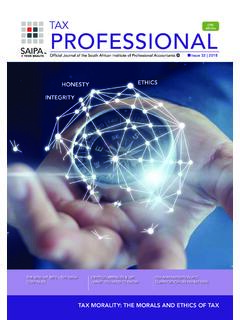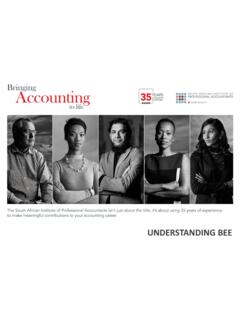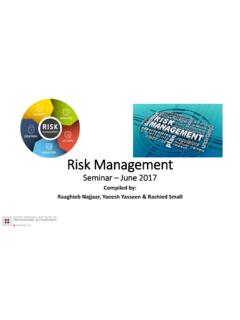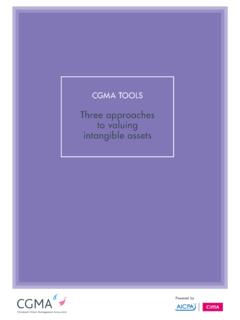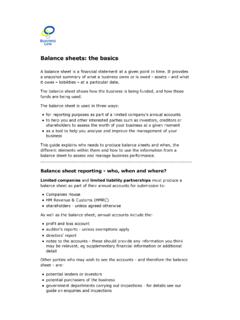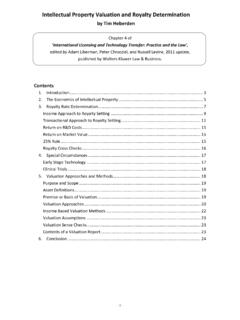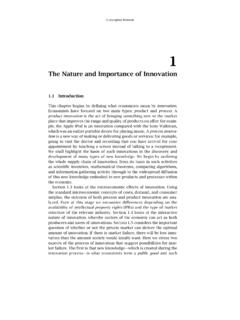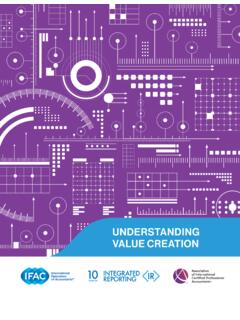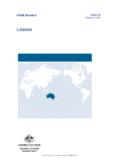Transcription of Business Valuations - SAIPA
1 Business ValuationsSeminar August 2017 Compiled by:Achmad Joseph, Yaeesh Yasseen & Rashied SmallBusiness valuation -ConceptBusiness valuation -August 20172 Business valuation is a process and a set of procedures used to estimate the economic value of an owner's interest in a Business . valuation is used by financial market participants to determine the price they are willing to pay or receive to affect a sale of a is the process of determining the economic worth of an asset or company under certain assumptions and limiting conditions and subject to the data available at the valuation date.[International valuation Standard Council] Business valuation -DriversBusiness valuation -August 20173 Business value driversFinancial leverageFuture performanceFinancial expected returnCash flowsAsset typesExit strategyBusiness valuation ProcessBusiness valuation -August 20174 Business valuation ProcessBusiness valuation -August 20175 Business valuation Risk & ReturnBusiness valuation -August 20176A direct correlation exists between risk and return the greater the risk the greater is the potential return.
2 However, investments with the highest returns often bears the greatest risk which can lead to financial risk an investor is willing to accept to maximize returns will depend on his/her risk appetite and risk tolerance levels. Business valuation Risk & ReturnBusiness valuation -August 20177 Business valuation Risk & ReturnBusiness valuation -August 20178 Business valuation Risk & ReturnBusiness valuation -August 20179 Business valuation Measuring ReturnBusiness valuation -August 201710 Business valuation Measuring ReturnsBusiness valuation -August 201711 Assumption of CAPM All investors aim to maximise economic returns All investors make decisions based on risks and returns Investors are rational and risk-averse Investors cannot influence prices price takers All investors have the same expectations towards input factors for investment decisions All investors has access to
3 Unlimited funds All investments as liquid and be sold at market prices No or insignificant transaction costsBusiness valuation Measuring ReturnsBusiness valuation -August 201712 Weighted Average Cost of CapitalMeasure the average cost of capital of the Business based on its capital structure represent the expected return for the businessWeighted Average Cost of CapitalFINANCING DECISIONS13 WACCM easure the average cost of capital of the Business based on its capital structureWeighted Average Cost of CapitalFINANCING DECISIONS14 CapitalReturnRatioAfter tax returnWACCE quity400,00022%67%22% financing150,00015%25% ,00012%8% ,000 Weighted cost of affecting Business ValueBusiness valuation -August 201715 Business valuation -Risk Factors Business valuation -August 201716 External Expectations of the economy Existing conditions in the economy Expectation of the industry Existing conditions in the industry Competitive environmentInternal Expectation of the Business Financial position / conditions of the Business Competitive position of the Business Nature and size of the Business Quality and depth of managementInvestment Risk factors of the investment Amount invested in the Business Expectation in capital appreciation Expectation in liquidity of the investment Level of expected
4 Management burdenBusiness valuation -Risk Factors Business valuation -August 201717 Business valuation -Risk Factors Business valuation -August 201718 Business valuation Industry RiskIndustry riskGrowth prospectsSupplier chain (Porter s 5 Forces)Competitive threatsSubstitute productsIndustry complexityTechnologyBusiness valuation -August 201719 Business valuation General FactorsBusiness valuation -August 201720 Business valuation MethodsBusiness valuation -August 201721 Business valuation MethodsBusiness valuation -August 201722 Business valuation asset -Based MethodsBusiness valuation -August 201723 Book Value MethodMethod represents the book value of the Business (assets liabilities)
5 Based on their market values going concernLiquidation Value MethodMethod represents the book value of the Business based on the liquidation values disposal valuesReplacement Value MethodMethod represents the book value of the Business based on the replacement values of the assets start-up businessBusiness valuation asset -Based MethodsBusiness valuation -August 201724 The following information isthe summaries statement of financial position:Book valueMarket valueNon-current assets240 000320 000 Intangible assets90 00050 000 Inventory180 000160 000 Other assets370 000370 000 Equity320 000 Non-current liabilities250 000250 000 Current liabilities310000370 000 Business valuation asset -Based MethodsBusiness valuation -August 201725 The following information isthe summaries statement of financial position.
6 Book valueMarket valueNon-current assets240 000320 000 Intangible assets90 00050 000 Inventory180 000160 000 Other assets370 000370 000 Equity320 000 Non-current liabilities250 000250 000 Current liabilities310000370 000 Net asset value320 000380 000 The book value of the Business is R 320,000 (minimumgoing concern value) will the net asset value (market value of Business ) is R 380,000 estimated selling valuation Net asset Value MethodBusiness valuation -August 201726 AdvantagesDisadvantagesAsset Accumulation Method is very useful when allocating the purchase price among the individual Business individual assets may vary significantly depending the basis used value the assetsUseful to value asset -based or property investment companiesMay be difficult in valuing individual assets as theassets may inter-dependentMethod ignores off-balance sheet asset and liabilitiesBusiness valuation Net asset Value MethodBusiness valuation -August 201727 Off-balance sheetAssetsLiabilities intellectual property items.
7 Such as internally developed products and services. Key distribution and customer contracts. Strategic partnership agreements. Pending legal judgments. Property and income tax obligations. Environmental compliance valuation asset -Based MethodsBusiness valuation -August 201728 The following information isthe summaries statement of financial position:3;1oqBook valueMarket valueNon-current assets640 000 Property will a carrying amount of R 120,000 generatesrental income of R 30,000 per annum and the fair return is considered to be 11%.Current assets570 000 Market value of current assets is estimated to be R 550,000 Non-current liabilities300 000 The loan is repayable in 5 years and bears interest at a rate of 10%.
8 The market interest rate is 12%.Current liabilities390000 Marketvalue of the current liabilities amount to R 430,000 Business valuation Intangible AssetsBusiness valuation -August 201729 valuation of Intangible AssetsIntangible assets can be valued using the following methods: Market value: based on market prices for similar transaction concluded recently Capitalised income: used for intangible assets that generate cash or income capitalised at fair return or discounted cash flow Cost based: estimation of the cost to reproduce the intangible assetForecasting -MethodsBusiness valuation -August 201730 Forecasting -MethodsBusiness valuation -August 201731 Forecasting -MethodsBusiness valuation -August 201732 Business valuation Capitalised EarningsBusiness valuation -August 201733 Factors to consider when estimating earnings.
9 Business model Market position Competitive advantage Product position Cost structure Strength of management Operating strength/weakness Location and accessibility Customer base asset base Barriersto entry Supply chain Business valuation Capitalised EarningsBusiness valuation -August 201734 The following information related to two unrelated businesses:Company A: fair earnings yield is 15%20X420X520X620X7 Earnings450,000480,000550,000630,000 Company B: fairearnings yield is 13%20X720X820X9 & afterEarnings230,000290,000350,000 Business valuation Capitalised EarningsBusiness valuation -August 201735 The following information related to two unrelated businesses:Company A: fair earnings yield is 15%20X420X520X620X7 Earnings450,000480,000550,000630,000 The value atthe end of 20X7: based on the historical trend in profits which indicates an increasing trend, the estimated future earnings is deemed to be a minimum of R 630,000.
10 Value of the Business based on the capitalisation of earnings amounts to R 4,300,000 [630,000/15%].Company B: fairearnings yield is 13%20X720X820X9 & afterEarnings230,000290,000350,000 Business valuation Super Profits MethodBusiness valuation -August 201736 Supper Profits methodThe supper profits method is used to reflect the value of the goodwill associated with the supper profits represents the additional profit the Business generates over its competitors in the market. The value of the profits capitalised for a specified period (usually a maximum of 5 years) represents the value of valuation Capitalised EarningsBusiness valuation -August 201737 The following information related to two unrelated businesses:Company B: fairearnings yield is 13%20X720X820X9 & afterEarnings230,000290,000350,000 Discounted value203,540227,1132,108,4722,539,125 The earnings represents the forecasted earnings,therefore the value of the Business should be based on the discounted value.
